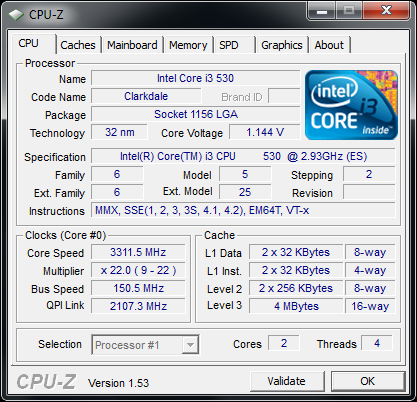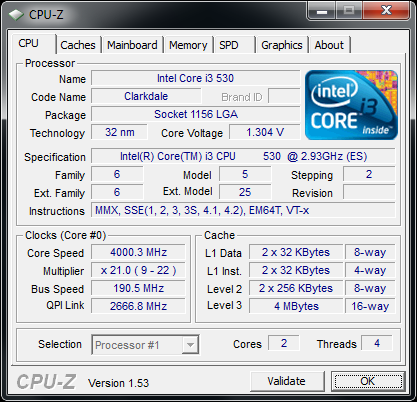The Intel Core i3 530 Review - Great for Overclockers & Gamers
by Anand Lal Shimpi on January 22, 2010 12:00 AM EST- Posted in
- CPUs
Overclocking the i3 - 4GHz with the Stock Cooler
I’ve become a fan of stock voltage overclocking over the past few years. As power consumption and efficiency has become more important, and manufacturing processes improved, how far you can push a CPU without increasing its core voltage appears to be the most efficient way to overclock. You minimize any increases in power consumption while maximizing performance. You really find out whether or not you’ve been sold a chip that’s artificially binned lower than it could have.
With Bloomfield, Intel hit a new peak for how far you can expect to push a CPU without increasing voltage. AMD followed with the Phenom II, but Lynnfield took a step back. Thanks to its on-die PCIe controller, Lynnfield needed some amount of additional voltage to overclock well. Clarkdale is somewhere in between. It lacks the crippling on-die PCIe controller, but it’s also a much higher volume part which by definition shouldn’t be as overclockable.
The Core i3 530 runs at 2.93GHz by default, with no available turbo boost. Without swapping coolers or feeding the chip any additional voltage, the most I got out of it was 3.3GHz (150MHz BCLK x 22). Hardly impressive.

I added another 0.16V to the CPU’s core voltage. That’s just under 14%. And here’s what I was able to do:

That’s 4GHz, stable using the stock heatsink/fan. Part of the trick to overclocking this thing was lowering the clock multiplier. Despite always keeping the QPI and memory frequencies in spec, lowering the clock multiplier on the chip improved stability significantly and allowed me to reach much higher frequencies.
I could push beyond 4GHz but that requires more voltage and potentially better cooling. With a stable 4GHz overclock, I was happy.
If you’ll remember from my review of the processor, my Phenom II X2 550 BE managed 3.7GHz using the stock cooler and a pound of voltage. Unfortunately it’s not enough to challenge the overclocked 530.
| CPU | x264 HD 3.03 - 2nd pass | 7-zip KB/s | Batman: AA | Dawn of War II | Dragon Age Origins | World of Warcraft |
| Intel Core i3 530 @ 4GHz | 18.4 fps | 2822 | 192 fps | 62.7 fps | 115 fps | 92 fps |
| AMD Phenom II X2 550 @ 3.7GHz | 10.4 fps | 2681 | 170 fps | 50.9 fps | 63 fps | 60.8 fps |
| AMD Phenom II X4 965 (3.4GHz) | 22.2 fps | 3143 | 196 fps | 54.3 fps | 109 fps | 74.1 fps |
Even an overclocked Athlon II X4 630 isn’t going to dramatically change things. It’ll still be faster in multithreaded applications, and still the overall slower gaming CPU.
If the Core i3 530 is right for you, overclocking is just going to make it more right.










107 Comments
View All Comments
Suntan - Friday, January 22, 2010 - link
Then again, it may just be that those people do have better stereos (or more importantly, better rooms and speakers) then yours.In any case, 99% of this website’s existence is possible because of the tendency for people to try and get “just a little more” out of their electronics…
-Suntan
Suntan - Friday, January 22, 2010 - link
In a word, yes. If your room/components/setup is worth it, then it can make a big difference.Analog output (and no, what you are doing is not LPCM) can compete sound-wise with digital output (either LPCM or bit streaming) if you have a quality soundcard (think Lynx 2B, not anything that says soundblaster) but even then, you lose other digital signal processing capabilities that a good AVR can offer (namely Audyssey Multi-EQ room correction and Audyessey Dynamic-EQ.)
That said, I too think it is a little over exaggerated. Simply because most people really wouldn’t notice the benefit in their situations.
Lastly, I happen to believe that the big flap over LPCM vs. bitstream *is* completely overblown. Ymmv.
-Suntan
Anand Lal Shimpi - Friday, January 22, 2010 - link
I agree that 8-channel LPCM is pretty much good enough. There are issues with players downsampling audio when outputting 8-channel LPCM from TrueHD/DTS-HD MA sources, but to my ears I could never notice the difference.Also remember that the majority of users don't even have 8-channel audio setups. We're talking 5.1 at best, and honestly a huge advantage of these high def audio formats is the support for discrete rear surround channels.
That being said, it's still a valid option to want. Blu-ray players have been able to do it for quite a while, there's no reason we shouldn't demand the same out of our HTPCs. Some users do prefer to keep the decoding on their receiver/preprocessor and for them it's the only option.
Hopefully by the end of this year all platforms will offer it and we can just assume its presence as a checkbox feature.
Take care,
Anand
cmdrdredd - Friday, January 22, 2010 - link
The big problem is some players mess with the audio during the decode and don't output LPCM in a raw untouched format. Bitstreaming means nothing is meddes with, no volume normalization and the like.archcommus - Friday, January 22, 2010 - link
Thanks all for the info, helped clear things up. With my 5.1 system and onboard audio with Windows 7 these days the software decoding and analog output is fine. But I guess in the future with a possible 7.1 system I would at least want LPCM over HDMI. I couldn't imagine needing bitstreaming unless I was building a true home theater.Spivonious - Friday, January 22, 2010 - link
LPCM is decoding the channels and sending them digitally over HDMI.I don't understand the big hype either, unless the decoder in your AVR is much better than the one in software. Otherwise the sound would be the same. I guess it's fun to get the AVR to display "DTS-HD".
blckgrffn - Friday, January 22, 2010 - link
Can we see what the 4ghz power consumption looked like? Was speed step still active? How about the OC'd graphics power consumption?Thanks :)
Anand Lal Shimpi - Friday, January 22, 2010 - link
At 4GHz the i3 530 used 129W under load, up from 101.4W :)I don't remember if speedstep was still functioning when I adjusted the clock multiplier, I believe it was but I'll need to double check.
Take care,
Anand
blckgrffn - Saturday, January 23, 2010 - link
Thank you!I guess it doesn't matter if speedstep was functioning if you could provide the idle power consumption of 4ghz as well.
The information is very much appreciated.
Deaks2 - Friday, January 22, 2010 - link
So were the the overclocking tests done on the Asus or MSI mainboard? Also, would the use of a P55 or H55 chipset affect o/c'ability of this CPU?